In the Immortal Words of Alanis Morissette and Prince....
Thank U! We can’t thank you enough for your support in 2012. All we wanted for Christmas was you, and here you are, so let’s put the Christ back in it together. Oh crap, I can’t get this Christ to fit. But thanks anyway!
The Year In Internet Outrage
The Year In Internet Outrage

Last weekend, in the wake of the mass shooting in Newtown, and the revelation that the person behind it might have been a troubled young man, a writer in Idaho, Liza Long, put up a blog post, “”I Am Adam Lanza’s Mother,” that purported to speak to the experience of Nancy Lanza, who had been her own son’s first victim. Tightly written and extremely candid about the violent rages and suicide threats of her son, it quickly spread beyond its original home on the web, picking up millions of pageviews from Gawker, BuzzFeed, the Huffington Post and other outlets looking for another weekend traffic jolt during a trying time.
And then the backlash began. Long was a bad mother, said those who’d trawled the other posts on her blog, which often took on the “take my kids, please” tone employed by so many mommy bloggers; she was seizing on SEO for her own personal gain, and using heartstring-tugging to elide serious issues; she was exploiting her son’s identity in other posts on her blog; she was a Libertarian Romney supporter using her exaggerated experiences to derail the gun control debate. Long released a joint statement with one of her detractors, then appeared on “Today”. And so on.
The way this single blog post ricocheted around the Internet — controversy begetting controversy, backlashes whipping against each other, each new entry dragging eyeballs toward it like it was a still-piling-up car accident — was a sped-up microcosm of how so many online controversies sparked and caught fire during 2012. Tempests brewed in tightly shut teapots, they would often boil over to the rest of the Internet, engulfing people in their argument-filled tide who sometimes seemed to not even realize what they were arguing about in the first place. The terse constraints of social media helped and hindered these debates, 140-character missives having the ability to be either succinct or glib (and, sometimes, both). At times, the playing to the angry seats seemed so blatant that it was hard to not wonder if people (and marketing departments) were trying their damndest to cut through the clutter of modern life by actively courting negative attention — but then again, why not do so, since trying to engender positive attention rarely attracts unless you’re a really cute cat. Here, a look at some of this year’s defining outrage points as they played out on the Internet.
“Girls,” Lana Del Rey, Sheila Heti, and other young female artists on the verge.
CRIMES
Being young and white and female, a.k.a. essentially serving as a mirror for people (especially older white males) to project their insecurities, and not realizing that they’ve been offered a space in the public sphere as spectacles for the crowd to watch get eaten alive as much as to honor their talent.
OUTRAGE PEAKS
Lana Del Rey’s twirly, drowsy “Saturday Night Live” performance, any public appearance by “Girls” creator Lena Dunham, the releases of Marie Calloway’s GChat-nudes-and-self-loathing-filled GDoc “collages” and Kate Zambreno and Sheila Heti’s semi-autobiographical work.
ISSUES TOUCHED ON
Misogyny, racism, class privilege, ageism, the “universality” of a woman’s perspective vs. that of a man’s, having to identify oneself as a woman artist instead of an artist who happens to possess female genitalia and how that affects the way one’s art is perceived by the media-industrial complex, feeling sort of like a traitor to your gender because while you appreciated the effort put forth by some of these artists you just kind of wished the execution was a bit sharper.
CYCLE SPEED
A new target seemed to come around every 28 days or so. (Just like a menstrual cycle! Get it?)
Chris Brown and Rihanna.
CRIMES
Unapologetically tweaking the noses of “music writers” forced by economic exigency to report on any/all artist-related gossip via their defiant use of Twitter and Instagram posts that, at times, unleashed the fervent-fan hounds on critics; shifting from crafting quality pop songs to churning out music that’s almost as vapid and unpleasant as their public personas.
OUTRAGE PEAKS
Will they? Won’t they? Wait, why is he dressed up like an extra from Hot Shots: Part Deux?
ISSUES TOUCHED ON
The cycle of domestic abuse; “do we really know what it’s like in a celebrity relationship?”; vague racism on behalf of people who were harassing Brown on Twitter, but who weren’t exactly protesting Charlie Sheen’s continued possession of a career; celebrity journalism phoniness; bad tattoos.
CYCLE SPEED
Endlessly looping, with no release in sight. Kind of like “We Found Love.”
The New York City Marathon.
CRIMES
Not getting canceled until the last possible minute, despite the devastation Hurricane Sandy had wreaked on New York days before.
OUTRAGE PEAKS
Probably hit its stride when some thwarted runners took a petulant photo underneath the now-useless starting line, not too far from hard-hit areas of Staten Island.
ISSUES TOUCHED ON
Privilege, mostly.
CYCLE SPEED
Pretty much dormant for now, although next November will surely see a couple of “I’m still mad about last year” clickbait posts.
Instagram.
CRIMES
Commodifying nostalgia via the application of photographic filters; revealing to the world how much people love photos of nail art and text-and-cliché-heavy images that are basically bumper stickers; selling out to Facebook after engaging Twitter in a long, value-enhancing con; informing users “LOL, your photos are free for you to upload, but they’re free for us to sell to ad agencies as well”; backtracking on that stance, sorta.
OUTRAGE PEAKS
The TOS change was the big one, although this writer feels rage any time she accidentally clicks on the tab featuring popular photos.
ISSUES TOUCHED ON
The commodified nature of “free” products put out by overvalued social media companies; fake nostalgia; the bumper-stickerization of human emotions; seriously, nails are not that interesting, come on.
CYCLE SPEED
Almost faster than it takes to develop an actual Polaroid.
Reddit.
CRIMES
Embarrassing media types who were delighted to use the site’s zeitgeist-predicting volunteers as their de facto assignment editors… until they realized that, ew, some of the maladjusted dudes spending all their time upvoting stories were even creepier than Peter Braunstein.
OUTRAGE PEAKS
“How dare you take away our First Amendment rights to take stealth pictures of women we worship from afar,” parts 1-infinity.
ISSUES TOUCHED ON
Misogyny; “misandry”; the rights of people on the Internet who violate the rights of women who have the gall to exist in public spaces while being attractive; the fact that some women actually fall for the tricks put forth by pick-up artists.
CYCLE SPEED
The traffic-generating prospects of Reddit mean that it’s again “OK,” even for the 13-year-old who pushed for the gender-neutral Easy-Bake Oven.
Our own awful senses of humor.
CRIMES
Revealing peoples’ inner Beavis and/or Butt-Head; unleashing “7:30 set at the Comedy Hut”-worthy yuks on the world in the name of feeding the content machine.
OUTRAGE PEAKS
The radio gag that had the world snickering at a slightly gullible hospital receptionist in the UK… until she offed herself out of humiliation; “The [Number] Worst [Genre] [Art Form/Artist Type] Of All Time”; “Can You Believe These People On Twitter Didn’t Know Who This Celebrity Was.”
ISSUES TOUCHED ON
What with all these hamfisted attempts at humor being especially popular during the workday, maybe we need to rethink the notion of “office productivity” in 2013.
CYCLE SPEED
Slow and grinding, like late-night molar activity that stems from being haunted by the notion that you might not be as original in your witticisms as you seem.
Misogynist Republicans.
CRIMES
Trying to strangle Planned Parenthood (and smearing the Girl Scouts while doing it); ignorance of basic biological facts; “legitimate rape”; trying to mandate medical procedures they’d never have to have; asserting that sexism was over because there were “binders full of women” floating around their interoffice mail. Basically, it’s what happened when you throw a book club full of people who think The Handmaid’s Tale was an uplifting book with a happy ending.
OUTRAGE PEAKS
Honestly, in 2012 it seemed like some GOP guy was putting his foot in his mouth every day.
ISSUES TOUCHED ON
The death rattle of the white heterosexual male’s cultural supremacy sure did result in an earthquake, huh.
CYCLE SPEED
You’d think the drubbing most of the people responsible for these bon mots received during the elections would have stopped women from being used as an easy oppression target, but then Newtown happened, and one enterprising writer realized that the absence of a coherent response on the Right’s side meant that women would have to return to their rightful victim status once more.
Outrage itself.
CRIMES
See above, then pick apart anything I left out.
OUTRAGE PEAKS
What peaks? The outrage cycle takes Andrew WK’s advice to not stop living in the red to a new level.
ISSUES TOUCHED ON
Everyone on the Internet secretly hates themselves, at least while they’re on the Internet.
CYCLE SPEED
A slow slog, until you walk away from the computer.
Previously in 2012 In Review: The Year In Cheating
Maura Johnston is not always in this bad of a mood.
New York City, December 19, 2012

★★★ Unconvincingly pleasant, with the falsely calibrated niceness of someone making a threat. Silvery morning brightness poured east to west along the cross street, in the heavens and the upper stories, while leaves and grit and litter blew from north to south down the avenue, swirling in the plywood chute under a scaffold. The blowing garbage was dry, though. Give it that. Practically the same thing as Noah’s dove’s olive branch. It was cold enough to put a knit cap on the toddler, under the hood of the hand-me-down puffy coat; it was not-cold enough for the toddler for the toddler to yank the cap off again. The schoolyard was all transverse reflections of light and redoubling long shadows, with puffy coats moving among them. Could be worse. Will be worse.
The Very, Very Best Holiday Beers To Bring To A Party

It’s the holidays! Time for fun and laughter and parties, parties to which you are expected to bring something or other. Can’t cook? Don’t want to be that guy that shows up with thirty McChickens? Don’t have 40 dollars for a set of Laguiole cheese knives for your hostess? Bring a nice holiday beer. And for recommendations, look no further: myself and nine of my favorite lushes got together this weekend and, over fondue and with a backdrop of holiday songs, tasted sixteen of the seasonal offerings. Here we’ve selected the best and shared our tasting notes.
A party with beer snobs: Delirium Noel
You will never please them, so just bring something like Delirium Noel. They won’t turn up their noses at it, but even if they do, so what? This beer’s delicious. More for you. Our reviewers “want to drink it while making latkes” and “would fall asleep drinking this,” hopefully not at the same time. It’s not like most other holiday ales, skipping the heavier spices for a light and bubbly caramel apple flavor. A complete delight from start to finish.
A family party: Troegs Mad Elf Ale Brewed with Honey and Cherries
At a family party, you can’t just waltz in with a six pack of Busch. I mean, you can, but everyone will treat you like the slob you are. Show your uncle, the one that still won’t shut up about that amazing zit you had in your seventh-grade class photo,* that you’re a real adult human with class. Watch as your lightweight mom spills a little on the carpet and just kind of rub it in with her foot — it’s holiday family memories! The Troegs is flavorful without being too sugary, with just enough of a cinnamon touch to remind you that it’s a holiday drink. Our reviewers said that they’d “drink a lot while opening presents,” and that if it were an animal, it would be “a cross between an Irish setter and a rhinoceros.”
A family party with slightly underage cousins: Woodchuck Winter Cider
Where the Woodchuck Pumpkin Cider was mostly a miss in our earlier pumpkin-beer bracket, Woodchuck Winter was a definite hit. A perfect balance between dry and sweet, the Woodchuck Winter would be a great one to pass to your favorite younger (not too young!) cousins. In a glass it can totally pass for the non-alcoholic sparkling kind of cider, but with the benefit of, well, getting them kind of tipsy. What are older cousins for? Our reviewers likened it to “French toast” and “a golden retriever.” Note: we used a bottle of this in the fondue and it was perfect.
Low-key drink-a-lots: Goose Island Christmas Ale
This kinda just tastes like a good beer. The flavor doesn’t make you think “yes this is a holiday,” but who says there’s anything wrong with that? It’s just neutrally good, maybe a slight taste of brown sugar in there. I would totally recommend this one for anyone that wants to drink something where the only frills to be found are on the label, which features a goose wearing a hat. The review notes are a little illegible on this one — we tried it late in the evening — but something about a ham? I guess it would go well with a ham.
Low-key drink-a-lots…in North Carolina: Olde Hickory Christmas Ale
One of the participants in our panel had recently returned from North Carolina and brought with her some Olde Hickory Christmas Ale. It’s an enjoyable, subtly spiced ale with orange peel and… is that caramel? One of our reviewers, in a discussion of its unassuming taste, called it “a pleasant large-quantity drinking experience.” Which was good, because we had a growler. I also have written down that it’s “the Lutheran mass of beers.” I don’t know what that means, but it seems like something worth sharing.
A party where you need a host/ess gift: The Bruery 5 Golden Rings
I am not a beer expert (enthusiast yes, expert no), I had to look up what was going on here: The Bruery is in year 5 of a twelve year long “Twelve Days of Christmas” series — one each year. This year’s is a gorgeous golden ale with allspice and pineapple juice. And it is SO GOOD — like, surprisingly so. Sweet and sharp. A perfect gift for the host that slaved over the stove all day to unwind with the next day, when all the guests are gone. One reviewer also mentioned that it would pair well with Chinese food. The same reviewer said that if it were a living thing, it would be “Home Alone-era Macaulay Culkin,” but that might just have been the influence of the John Williams song on the stereo at the time.
All Purpose Can’t Fail: Southern Tier 2Xmas
I am totally biased on this one, I admit, but it’s only because Southern Tier has never done me wrong. Supposedly brewed in the tradition of Swedish Glogg (and sure, I’ll take their word for it!), this beer is, according to a reviewer, “like a gingerbread house in a bottle.” It’s ginger-y, nutmeg-y, and almost a little icing-y. This beer will leave you feeling warm and sated. In fact, if I hadn’t already called it the gingerbread house of beers, I’d totally call it the wool sweater of beers. The first ski of the season of beers. The all-purpose can’t-fail holiday beer of beers.
Oh Christ, I just dropped my pie in a snowbank and I was supposed to bring dessert: Mikkeller Santa’s Little Helper (and a pint of vanilla ice cream)
Well spiced, smooth and dark chocolate-y, this beer is sturdy enough to be a dessert on its own, but pour some of this lil’ beaut over a scoop of rich vanilla ice cream, add a bendy straw, and it’s beer floats for all! Reviewers agree that it would be “absolutely horrid with Cheetos,” but basically perfect with anything else, including as an ingredient in chili. I would eat that. As a dessert course, it would be heavenly.
Standing in front of the beer case and still can’t decide? Here are three I’d definitely pass on:
• Anchor Brewing Christmas Ale: “reminiscent of a nail salon,” “this actually hurts to drink”
• Ridgeway Bad Elf: “a seasonal kind of nasty,” “no no no no no no”
• Hoppin’ Frog Frosted Frog: “cinnamon water,” “tastes like a yankee candle”
* You will have to take my word that it was magnificent.
Previously: The Great Pumpkin Beer-Off
Victoria Johnson has already watched Die Hard twice. Photo by Kia Matthews.
Buy Punk
If you’re still shopping for that special someone, you could do worse than The Best of Punk Magazine. I mean, depending on who you’re shopping for. Learn more here!
Inspirational Drake: Because Getting A Forehead Tattoo Is Too Much
by Myles Tanzer
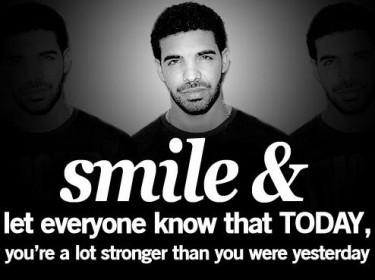
A series on the stuff that delighted us on the Internet this year.
This year everyone one was saying (again!) that the Internet is a nice place to hang out. Listen, I grew up as the Internet grew up, and between the mystery AIM screen names we used to bully each other, the group Xangas where we trashed our friends, and the real life Gossip Girl clones and college slut-shaming sites that popped up as I grew up, I know that the Internet can never be a nice place. Also, I’m not sure what Internet everyone else has been using, but my Internet in 2012 was filled with subtweeting and shit-slinging all around. No one rules the Internet like the evil among us.
But there’s really only one thing I need to restore my faith in humanity and that’s my one and only Canadian heartthrob with the brow bone that could break me into one million pieces. Perhaps I’m going a bit overboard, but my favorite web thing of the year had to be what’s known as “Inspirational Drake.”
It’s pictures of Drake with inspirational quotes written all over his mug in all types of swirly and boldfaced fonts. The best thing about them is that the large majority of these quotes aren’t even song lyrics from his songs, they’re just anonymous aphorisms for the lonely and the under-appreciated. They’re like pictures of cats that get your groove back because, well, Drake.


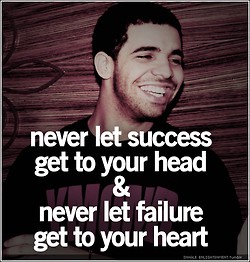
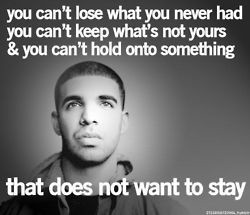
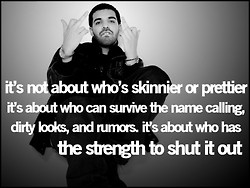
Above are some of the finer examples of Inspirational Drake, the last one being my favorite. Although Drake never said that quote about “dirty looks and rumors” one can almost imagine him warbling it out on a 40 beat. Only the fourth one is a real Drake lyric (it’s from the tender “Houstalantavegas”) and it’s sadly the least moving one.
In terms of popularity, Inspirational Drake is on the really low end of the scale, which is great. If it were a movie in 2012, it would have to be The Five-Year Engagement, that sleeper romantic comedy with Emily Blunt and Jason Segel. It was kind of sweet and just left alone. A comparable album would be Brandy’s Two Eleven: good, but largely ignored. If it were a Drake feature from 2012, it would definitely not have the fame and umph of his summer smash “Pop That,” but it’s way more alike in tone and popularity with his assist on Mary J. Blige’s, “Mr. Wrong.”
You can stick these Drake pictures anywhere really. I think Instagram is pretty much the most appropriate place though. Definitely not for Twitter.
A good way to read them is picturing Drake saying them like the outro to one of his most bitter kiss off songs, “Shot For Me.” Thanks to that YouTube video we’ve just created another one to add to the canon:
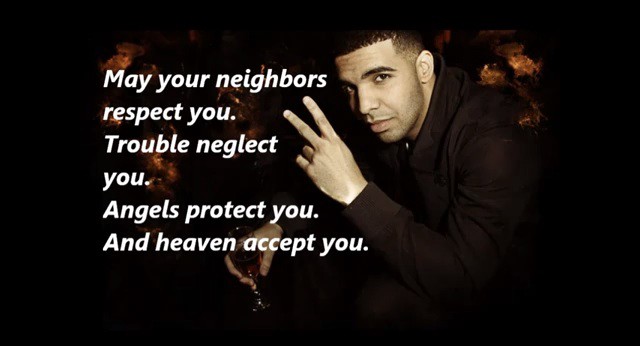
It’s that easy, folks.
But the real best way to think of these image macros, sorry!, is to picture them not written by lovesick teens or bloggers in hopeless unrequited love with Aubrey Graham (hi!), the real way to read these, and this may even be true, is to picture them being written by Drizzy himself.
One can almost picture Drake, smelling like vacation, sitting with a laptop in front of an outdoor fire place, with his wacky brown-tinted glasses, and open jazzy man shirt.
I’d like to think that Drake makes these on Picnik, but unfortunately Google ruined that priceless tool that used to help me quickly throw paper crowns on people’s heads and put ironic leaf borders around pictures of my friends. Without the incomparable ease of Picnik, Drake must have to use MS.Paint to create all of these beauties.
Because there’s no leaked nudes of Drake (I’ve checked!), I’d imagine that these are what Drake uses instead of sexts. One can imagine Drake crouched over his computer, snapchatting models inspirational messages of his face painted with unreleased lyrics.

Then these girls quickly manage to grab screenshots of his messages and they post them to Tumblr. And Drake cries.
Previously in series: Wurtzel, Crichton & Yoo: Inside The Delightful ‘Harvard Crimson’ Archives
Myles Tanzer is the editor-in-chief of NYU Local and a Gawker weekend scribe. He hopes this post will bring him one step closer to Drake.
"Baby Jesus Stolen" Nativity News Watch 2012
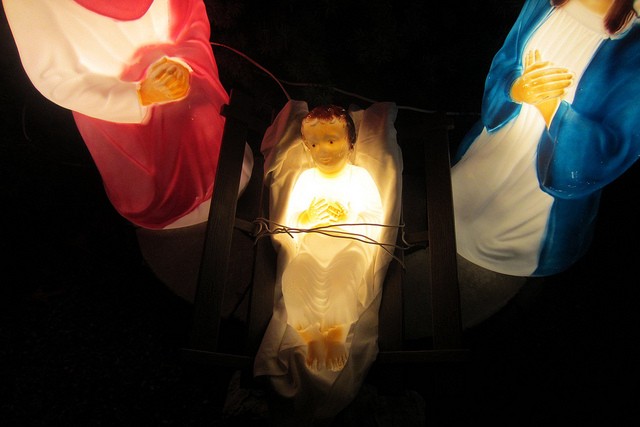
According to the latest tally on Google News, there are 2,803 current media reports involving stolen Baby Jesuses from nativity scenes. This represents a [made up percentage] increase in nativity infant thefts over 2011, which had held the previous record with [made up number] documented desecrations of Christmas scenes. Many are wondering just how low we can go, as a species. If children and other pranksters think it’s “okay” to lift a plastic baby with a hole in its bottom for a colored light bulb, then what else might people do, given the chance?
“It is one thing, I guess, to steal even the shepherd or a king,” said teacher Mary McKernan. “But a baby Jesus? It is so sacrilegious.”
“Jesus is the reason for the season. So we should have him out there so that we can remember why we have Christmas,” Olson Tire Service customer Augusta Davis said.
“I said, ‘Hey, baby Jesus is gone,’” parishioner Marvin Marotz told the congregation of St. Paul Lutheran Church. “I kind of shocked everybody.”
“I noticed early in my shift that the Baby Jesus at the Burlington Park was missing,” the Lawrence County sheriff’s deputy wrote in his report. “I talked to Cory and William and they did advise they were in the car all day and did notice that the Baby Jesus was in the back seat where they were sitting. But all three individuals wouldn’t tell who had actually taken the Baby Jesus.”
“There was some discussion about using gorilla glue next time,” Pastor Brian Crocker said. “I think we will continue to put it out earlier in the Advent season, I know some people enjoy seeing it and for more than just one or two days a year.”
“I know he (Baby Jesus) was wired down,” Pastor Jim Higginson said. “They couldn’t just pick him up. They had to cut him loose.”
“It had horns drawn on it and a hole in its chest,” Huntington Detective Chris Sperry said. “Now every time I go down 5th Avenue I can look up, my kids can look up, and they can say ‘My dad fixed that.’ That gives you a good feeling.”
“I have no ill will to whoever stole Baby Jesus,” Linda Thomas wrote after the stolen Jesus was returned to her home in Conroe, Texas. “Just forgiveness. It’s very encouraging to witness good triumph over evil intentions, especially in light of tragedy in America. There is hope in Jesus Christ. The incident with Baby Jesus is a wonderful reminder to all of us that Jesus Christ is the centerpiece and the reason for Christmas.”
Photo by twodolla.
The Great, Forgotten Sci-Fi Novel About The End Of The World
by Maria Bustillos and David Roth

David Roth: So, tell me again, please, how you found this novel, The Last Western? I know how I found it, which was by you giving me a copy and telling me it was important that I read it.
David Roth: It was like Natalie Portman’s “The Shins will change your life” moment in Garden State, except you are shorter, smarter and less pointy than she is, and I am marginally less grumbly-sad than Zach Braff, and you were right and also The Shins couldn’t conceivably really change anyone’s life.
Maria Bustillos: A guy named Mark Harris went all crazy over it on this listserv I was on back in 2002, and he persuaded me. So I went and found a copy (not easy, it has been out of print since the 1970s) and had my wiglet blown sky-high. I was so happy you loved this book, David. This beautiful book about the end of the world.
Maria Bustillos: I want everyone to read it. So back in the day, I offered my copy to this listserv, and there was a monk in Klosterberg, Germany, who agreed to read it, his name is Erwin and he taught me even more and more about it, and he became one of my best friends.
David: How my friend Maria joined the Sacred Order of the Very 1970s Catholic Social Apocalypse/Baseball Novel. Given that only like 50 people alive have read this thing, we should probably run down what happens in it.
David: So: a child is born in a doomed outpost, in a time Very Much Like Our Own circa the shittiest Watergate low ebb of everything. He moves to a more-doomed Houston. Develops an unhittable rising fastball and makes it to the Bigs, just like Byung-Hyun Kim did. Leaves the league because of some complicated metaphysical reasons, unlike the way Byung-Hyun Kim did. Houston is levelled by riots. Our hero joins a secretive monastic order. Becomes a priest, is assigned by the Vatican to the rioting inner cities… we are not yet halfway through.
David: But it’s not all that sprawling, considering. It covers a lot of ground and time, but it stays centered on Willie, our Christ-ly hero with the 8-grade fastball.
Maria: All this is TRUE but doesn’t actually touch what’s being said, which has the subtext: how is a just man to live in an unjust world?
David: Right. Which is a pretty ambitious question for any novel. And which Klise decidedly does NOT make any easier for himself.
Maria: Continuing: Willie has a relationship with a more worldly boy, Clio, who understands him but is frustrated because saints can’t be real people: protect yourself, he is saying. Kind of like Anne Hathaway telling Batman, “Let’s get out of here.” But it’s not like the world is safe for anyone.
Maria: The style of it is very curious, simultaneously the most naive style you’ve ever seen, and the most sophisticated one. Klise is a very undeceived writer; this thing goes to the fucking mat, page after page. Not even Thomas Mann was this brutal. But it’s science fiction, too. The cover blurbs are from like Philip Jose Farmer.
David: Such great 1970s cover blurbs. Weird journals that don’t exist anymore.
Maria: The cover, too, is perfect.
David: Some guy from Commonweal saying “Thomas S. Klise, you have written more than a novel, you have written a revolution… This may be a turning point in American literature, if it is not the final climax.” So an A-minus overall, then, presumably?
David: There’s something amazing about a book this spectacularly distinctive, strange and good becoming this obscure, though.
Maria: The author died really young; that’s part of it.
Some guy from Commonweal saying “Thomas S. Klise, you have written more than a novel, you have written a revolution… This may be a turning point in American literature, if it is not the final climax.” So an A-minus overall, then, presumably?
David: It’s not un-flawed, obviously. It’s VERY STRANGE and very 1970s in the sense, shape and scope of its doominess. But it has disappeared utterly. Thomas S. Klise doesn’t have a Wikipedia page.
Maria: Plus it’s also HILARIOUS, which I can’t even fathom how he manages that.
David: It’s his only novel.
Maria: Alas!
David: And a new copy will run you $245 on Amazon (although there are some used ones for more like $35)
Maria: There are only fifteen copies on ABE just now. Full disclosure, I am inflating the price single-handedly, I’m afraid… every time I see one under $20 I buy it and give it to some deserving soul.
David: Maria Bustillos stays moving markets.
David: And for all the romance of an actual classic that’s so utterly disappeared, the book really does deserve that sort of treatment. It would if it somehow wound up back in print (ahem), too.
Maria: Here is a passage for our readers to try. Very hard to choose. It’s a discrete experience, unbreakable, so this is like telling one moment from a long dream. But here the mute pilot Truman shares the story of his life, in signs, with our hero.
His first signs portrayed childhood — growing up in a large city.
Happy father. Happy mother. The father goes away. A uniform of some sort. The father flying. The mother and son together.
Then sadness. Something happening to the father. Hurt. In jail.
Joy. Great unexpected happiness. Father comes back.
But not joy after all. Something has happened to father.
Now moving away. Father and mother and boy going somewhere. Many somewheres.
Flying.
The Man of Sorrows made airplane movements with his hands — strange, dangerous, wild movements.
“Stunt flying — for a carnival,” Father Benjamin whispered.
The strange dangerous flight gestures continued. Then — smack! The airplane had plunged into the ground. Father dead.
Pause.
Now the mother and son moving again. Something about a name. Something has changed.
Willie strained to see the signs the Man of Sorrows made.
The mother has gone now. More flying.
This time, he, the Man of Sorrows, is flying
Stunt flying.
Pictures. Something to do with movies.
Then more flying. Flying to other countries. Some kind of flying mission. Flying food — no, blood — somewhere.
A place of war.
Maria: So my friend who is very very well-read and who was a monk at that time and is consequently super-conversant with Catholic literature said this about the book: “What I found ambiguous in this context was the continuous ‘deep’ rage and desperation of the tone, which sometimes felt like a pose, and with time started to get on my nerves, and also reminded me of a former flatmate who was a Dead Kennedys fan. I found it horribly ‘Seventies’ in its ‘naive’ and essential cultural criticism […] with conformist clothing styles representing reactionary world views (men in dark suits with black sunglasses) […] But perhaps naivete and essential cultural criticism aren’t such bad things after all, at some point in my life I even entered a monastery, so what am I talking.
What I found truly unctuous was the juxtaposition of Europe as cultivated and decadent (the comments on the art in St. Peter) and America as down-to-earth, ultra-capitalist but also the home of the naive and righteous. […] In this respect it tells much about ‘the’ North American self-image (sorry for generalizations of this sort; almost all Americans I got acquainted with in Germany spent most of their energy in being embarrassed by being Americans, especially when there are others within sight, while at the same time finding everything worse than in America; self-referential paradox again).”
This, by way of explaining the kinds of things you will be thinking about when you read the book.
David: That’s a wise monk. And all the doomed-ness is heavy; overstatement is everywhere. It doesn’t exactly duck parody. And yet there’s this sense of command, broadly.
Maria: It’s funny and it is supposed to hurt. And it does, a lot. Hurts like Kafka, or worse even.
David: But the book is also in this weird tone of high-volume satire/parody.
David: There’s a George Saunders-y overstatement to a lot of it; some of the images — the weird Martha Washington doll for kids that has different moods and burbles little weird patriotic aphorisms, for instance — are just hugely Saunders-ian.
Maria: The Saunders comparison is apt. We MUST send him a copy, I wonder if he has heard of it?
David: A lot of it has that Saunders feel, the heightened unreality and the very real and very despairing critique in the same weird space. This generalized disgust with crass marketplace things taking some very specific and very weird shapes. The difference, for me, is that Saunders’ disgust is with a world I recognize a good deal better than this one. Our materialism is obviously state of the art relative to the 1970s, awful as I’m sure it was then; I wasn’t alive, but I have seen Nashville (LADIES). But that Nixon-era sense of apocalypse-by-the-end-of-the-week is foreign to me. But it’s urgent enough that it still works, even as the book dials up the overstatement.
Maria: Holy moly this is one of the rare times I feel the generational divide between us, David. I think things are a good deal scarier now.
David: Oh, I would never say that things aren’t scary as shit. Let me get on the record with that: everything is fucked and feels very fucked. Go on.
Maria: What with the stone fact that the planet won’t support an Indian middle class, let alone a Chinese one, at the current rate of emissions. And our politics are so pathetic, like trying to move the Himalayas with a teaspoon.
David: Well, yes. So many things creeping upwards, in some cases very quickly. But the mood of the big pieces of art from the 70s — and I’d put this up there, with something like Apocalypse Now — reflect a very violent, very urgent and very specific sort of gloom that feels sort of foreign, now.
Maria: Hmm, that is true.
David: We play with it, now. Batman is “dark,” for instance, but it’s mostly a game. There are people who take it very seriously, I guess, and I like the movies fine, but that’s not a worldview, necessarily. It’s a half-reasoned gloom-o edginess in a movie with a billion dollars behind it.
Maria: You have like Houellebecq, too, kind of similarly, there’s a bleak view of individuals more than of the whole human project. Maybe we are so scared now of the world really ending that we are too scared to talk about it.
David: And Houellebecq has that willingness to go big and get weird. He doesn’t necessarily mind blowing up a bunch of people to make a point.
Maria: I love that about him. So creepy, but I love it.
This shocking rewriting of history, for entertainment. Let’s imagine it the way it ought to have been! There is something giddy about it, sunshiny and horror-striking at once. Where Klise is saying, by golly, those fast-approaching clouds are black.
David: But that’s not where novels really are, now. There’s a retreat to the human scale — which is broadly good, although not necessarily less grandiose if, say, Jonathan Franzen is doing it. And then there’s this abstract-o magical mystery tour upper-middle-class self-actualization fantasia thing.
Maria: Inglourious Basterds, I was going to say, is kind of the anti-Klise.
David: How so?
Maria: This shocking rewriting of history, for entertainment. Let’s imagine it the way it ought to have been! There is something giddy about it, sunshiny and horror-striking at once. Where Klise is saying, by golly, those fast-approaching clouds are black. And they are real. And they are coming.
David: As much of its time as it is, though, I don’t think The Last Western is quite an artifact. Or just an artifact. If only because of the way that our current brand of awfulness — The Way We Suck Now — sort of echoes the 1970s. We just have much more advanced phones.
Maria: Beyond that, even. Mark Harris thought that Klise might have had trouble selling the book because of its religious (or, if you like, anti-religious) themes.
Maria: But for this reader the utter fearlessness, the strange naivety, with which the author engages bedrock moral questions is unsettling in exactly the way that we need, and that is seemingly absent from our fiction now.
David: Except for George Saunders, who’s a lot more Buddhist than Klise, I think that’s right. And it’s not like these are settled issues. No one was like, “we’ve figured out how to be good in a bad world, so let’s try to figure out what makes rich white folks’ marriages fall apart.”
David: What’s striking is that, among the How Can We Live writers doing that sort of thing now (and Saunders is my favorite, but there are others), Klise is actually fairly explicit and non-abstract in how he faces that question down. And this is a guy who wrote a book about an illiterate kid who throws a fastball with a lot of late movement and who later becomes THE POPE.
Maria: Right? Which sounds like Terry Southern BUT MAN, IT AIN’T.
David: Yeah, this is awfully rough and despairing for satire.
Maria: The pea of moral seriousness under the various shells of satire. But with Klise you lift every shell and there is a pea under each one. It’s unnerving.
I guess I would add that today’s despairing fictionalist isn’t grabbing the reader by the throat and demanding not only that he confront his own complicity but that he change his ways, this instant.
David: Maybe what grounds it, or keeps it from floating into the sort of meta-satirical space of its more contemporary near-counterparts, is that Klise doesn’t really fuck with mass media. The movie-related aspects of the book — and we’d be spoiler-ing to go too far into this — seem more to do with authorial meta-issues than any indictment of how that particular business shows us things.
Maria: I agree. Here is some period-specific comedy that reminds me a little of Klise’s attitude toward the absurdity of the Catholic institution.
David: So, you know more about all the Christian stuff (that is: you are not Jewish) than I. Just how heretical is this book?
Maria: Oh, completely. It’s a complete indictment of the Church as the repository of Christ’s teaching. Mind you, this kind of soul-searching is part of the liberal wing of Catholic teaching. You have a left and right, Vat II and like, anti-Vat-II. But Klise is scathing about Church’s elemental betrayal of the things Jesus advised. Trying to care for the poor, end war and so on.
David: But not at all really heretical about the teachings. The book is frankly very Christian and reverent, actually, about those.
Maria: Kind of? I don’t even know really about reverence for the Gospel, though. More like, reverence for the excellence (or necessity) of these ideas that Jesus had: take care of poor people, end war, try to figure out how to be good. Though I believe Klise was a practicing Catholic.
David: And this is maybe me being the age I am, but all that fussing and fuming and for lack of a better word caring about the church seemed sort of dated to me, too.
Maria: I asked my monk friend about all that back when I first got to know him. I said something like: How does someone like you (practically the most serious and intelligent person I’ve ever met, loves the Psychedelic Furs, and plays the piano like an angel; turned me on to Žižek and Theweleit, explained all these things about Foucault) — how do you manage this? With all the trouble in the Church, how do you manage it?
Maria: And he responded with something like: The standard answer is that the Church is a heavy burden on the weak shoulders of men, in short kind of like, “we are bound to fuck it up, like we do everything.”
David: Not at all a dated sentiment. We just keep that shit current every day.
Maria: Yeah. So do you think the world is going to end, David?
David: I’m of two minds on the apocalypse.
David: (I just wanted to type that.) I certainly have a difficult time, looking at the things that are wrong and the responses they’re engendering, feeling too optimistic about solutions. The abstraction and the deep and dimly understood grievances and the distance, all these different types of retreat: those are a bummer both because they give us a shitty discourse and stupid art, but also because problems as big as ours require non-individuated solutions, and a basic recognition that other people are as important as we are, and that we all ought to be thinking about each other a bit more. And working on that. Current events and all.
David: But on the other hand: we’re still here. People can be great. And the alternative to not fixing things is not tenable. The status quo is not tenable. People seem to be realizing this.
David: It’s difficult not to. I just can’t see how that translates, or what it translates into.
Maria: Well, here we are, agreeing about that, so there is a chance; where two or twenty or two thousand can agree, so can multitudes. Sometimes I fancy I can almost feel the change coming. I do not believe the world will end anytime soon, in part because it’s been ending my whole life. There are always surprises, fair and foul. Things are dire, certainly, but I have what I am going to have to call faith.
David: It’s something. There are, at least, still good books to read that haven’t been read before. So: work to do, then.
Before the end of the world hits, you might also enjoy reading: The NASA Scientist Who Answers Your 2012 Apocalypse Emails
Or re: Saunders: The Joys Of The George Saunders Style Sheet
Maria Bustillos is the author of Dorkismo and Act Like a Gentleman, Think Like a Woman.
David Roth writes “The Mercy Rule” column at Vice, co-writes the Wall Street Journal’s Daily Fix, and is one of the founders of The Classical. He also has his own little website. And he tweets inanities!
Welcome In Winter
The world may or may not end tomorrow (SPOILER: it definitely won’t; we’re not meant to be that fortunate) but autumn certainly will. That’s right, here comes winter. As we make this transition, enjoy these two tracks I associate most with the respective seasons. And welcome in winter. Now at least your soul will be caught up with the calendar.
A Poem By Jameson Fitzpatrick
by Mark Bibbins, Editor
Foreplay
I’d like a bunch of un-
lit lilacs, please. A lie
lacking malice.
A black eye.
I’d like a palacefull. A pool
of lack to lie in. A lilac
lacking pull. A slack sleep.
A new rule for lying.
A slick slap. I’m a sap
for lilacs — shouldn’t
tell you that. I’d rather
unwrap a Cadillac.
Jameson Fitzpatrick lives in New York, where he’s pursuing an MFA in poetry at NYU.
We drew you for Secret Santa, and we decided to get you a whole bunch of poetry. You’re welcome! You may contact the editor at poems@theawl.com.
